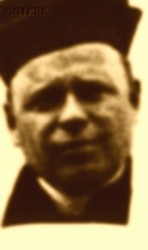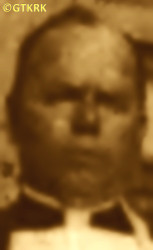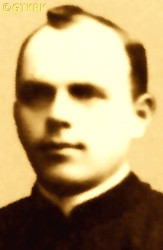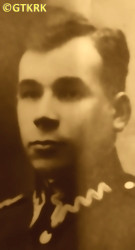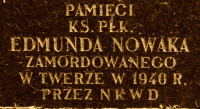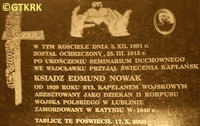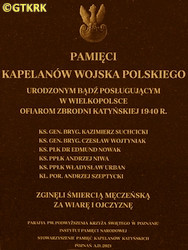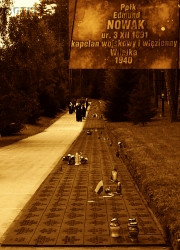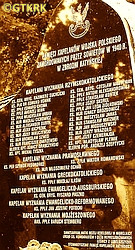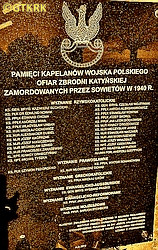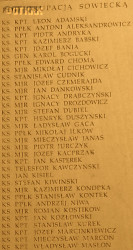Roman Catholic
St Sigismund parish
05-507 Słomczyn
85 Wiślana Str.
Konstancin deanery
Warsaw archdiocese, Poland
full list:
displayClick to display full list

searchClick to search full list by categories
wyświetlKliknij by wyświetlić pełną listę po polsku

szukajKliknij by przeszukać listę wg kategorii po polsku

Martyrology of the clergy — Poland
XX century (1914 – 1989)
personal data
surname
NOWAK
forename(s)
Edmund
function
diocesan priest
creed
Latin (Roman Catholic) Church RCmore on
en.wikipedia.org
[access: 2014.09.21]
diocese / province
Włocławek diocesemore on
en.wikipedia.org
[access: 2013.05.19]
Włocławek i.e. Kalisz diocesemore on
pl.wikipedia.org
[access: 2019.10.13]
RC Military Ordinariate of Polandmore on
en.wikipedia.org
[access: 2014.12.20]
academic distinctions
Doctor of History
Philosopy MA
honorary titles
War Order of Virtuti Militari — Silver (5th Class)more on
en.wikipedia.org
[access: 2019.10.13]
(11.11.1976, Londontoday: London Cou., England, United Kingdom
more on
en.wikipedia.org
[access: 2024.03.19], decree of Stanislav Ostrowski, President of the Republic of Poland in exile)
September Campaign Crossmore on
pl.wikipedia.org
[access: 2023.11.24]
(01.01.1986, Londontoday: London Cou., England, United Kingdom
more on
en.wikipedia.org
[access: 2024.03.19], decision of George Premyslav Morawicz, Minister of Military Affairs of the Polish Government in exile)
„Polonia Restituta” Cross — 4th Class, Officer'smore on
en.wikipedia.org
[access: 2019.04.16]
Gold „Cross of Merit”more on
en.wikipedia.org
[access: 2019.04.16]
(10.11.1933)
Commemorative Medal for War of 1918–21more on
pl.wikipedia.org
[access: 2019.10.13]
Ten Years of Independence Medalmore on
pl.wikipedia.org
[access: 2019.10.13]
Cross of Valor of the former Volunteer Allied Army of General Stanislav Bułak–Bałachowicz
date and place
of death
04.1940

NKVD TverHQ at 17 4 Sovetskaya Str
today: Tver Medical Institute, Tver oblast, Russia
more on
en.wikipedia.org
[access: 2021.10.09]
alt. dates and places
of death
05.1940
details of death
During World War I, after the Russian defeat in 05.1915 in the Battle of Gorlice, the expulsion of the Russians from Eastern Galicia and Belarus, and the establishment by the German occupier of the Germ. Kaiserlich–deutsche Generalgouverment Warschau (Eng. Imperial–German General Government of Warsaw), with its seat in Warsaw, and by Austria–Hungary the Germ. Militärgeneralgouvernement in Polen (Eng. General Military Government in Poland), with its seat in Lublin, his parish found itself in the area occupied by Germany. Opposed the orders of the German occupation authorities, attempting to introduce the Lord's Prayer and religious education in German into schools, and was arrested three times for this.
In 1917, during ministry in Działoszyn, collaborated with the clandestine Polish Military Organization POW — Działoszyn was then under Austro–Hungarian occupation, in the Germ. Militärgeneralgouvernement in Polen, right on the border with the territory occupied by Germany, or the Germ. Kaiserlich–deutsche Generalgouverment Warschau.
In 1918, towards the end of the war, again opposed the orders of the German authorities, this time concerning grain quotas for the Germans — and was interned. Released thanks to the intervention of the landowners and his parishioners.
After the end of the war and the establishment of the Polish state, during the Polish–Russian War of 1919‐1921, volunteered for the Polish Army on 05.05.1920. Became a chaplain and educational officer of the 3rd Silesian Uhlans Regiment. The regiment, as part of the 7th Cavalry Brigade of the 3rd Army, took part in the so‐called Kiev expedition, aimed at preempting the prepared Russian offensive and attempting to create a stable Ukrainian state, friendly to Poland. On 26.05.1920 the Russian offensive began and on 08.06.1920 the Poles began to withdraw from Kiev. At that time the Regiment was the rear guard of the 3rd Army, fighting bloody battles with the attacking Russians. Among others on 29.07‐03.08.1920 took part in the Battle of Brody and Beresteczko. On 15‐16.08.1920 found itself c. 40 km east of Lublin. The decisive Battle of Warsaw (known as the „Miracle on the Vistula”) was just beginning and the Regiment fought a heavy battle with the Russians near Cyców. Immediately afterwards it took part in the Polish counter–offensive from the Wieprz River — on the line Biała Podlaska – Białystok – Augustów, which entered the rear of the Russian troops, breaking its support lines and causing a general retreat of the Russians to the east. In the area of Augustów the Regiment had to deal with the Lithuanians, who, taking advantage of the Russian offensive, attempted to occupy part of the Polish lands, including attacking Augustów. On 20‐28.09.1920 took part in the victorious great battle on the Neman River, which decided about the Russian defeat in the north — fighting on the line Druskininkai – Nacha – Lida. After the end of the fighting prob. became a chaplain of the infectious diseases hospital in the Grodno garrison, although until mid‐1921 his Regiment served further to the north–east, in the area of Glubokoye, in the north of the Polish–Lithuanian demarcation line.
The 3rd Regiment was then withdrawn to the Upper Silesia. Prob. together with it, or perhaps a little earlier, also found himself in Upper Silesia, after the plebiscite (Germ. Volksabstimmung in Oberschlesien), ordered by the Versailles Peace Treaty of 28.06.1919, which ended World War I. The plebiscite was held on 20.03.1921, and its results — also due to the mistakes of the Polish side — turned out to be unfavourable for Poland. Preparations for the Third Silesian Uprising began. On 02.05.1921, the Supreme Command of the Insurgent Troops NKWP, the highest Polish military body, was established. Became then the chaplain of the „East” Group of the Pastoral Department of the NKWP. The uprising broke out the next day and lasted till the armistice on 05.07.1921.
During German and Russian invasion of Poland in 09.1939 and start of the World War II head of pastoral chaplaincy at „Lublin” Army of the Polish Forces (since the mobilization in 08.1939).
Prob. till 14.09.1939 remained in Lublin, together with Regional Corps DOK No. II HQ, and then left — together with the DOK No. II commander, Gen. Mieczyslav Smorawiński — in accordance with orders towards Kovel, and following that to Volodymyr‐Volynskyi.
There was caught by the Russian aggression against Poland, which began on 17.09.1939. After the invading Russian army reached Volodymyr‐Volynskyi — on c. 20.09.1939 — prob. intended, in accordance with the agreement negotiated with the Russians by Gen. Smorawiński, to move with his troops westwards, towards Bug river.
On 20.09.1939 however, when leaving Volodymyr‐Volynskyi all of them — including General Smorawiński — were apprehended by Russians and „interned” in NKVD filtration camp PFL Shepetivka.
From there transported east, to KLW Kozelsk concentration camp in Kozelsk (or KLW Starobilsk camp in Starobilsk).
On 23‐24.12.1939 moved prob. to Butyrki prison in Moscow and on 29.12.1939 to KLW Ostashkov concentration camp in Ostashkov.
From KLW Ostashkov — his name is on the NKVD deportation list No. 05/3 prepared on 05.04.1940, item 71 (case No. 1331), with an order to be placed at the disposal of the head of the NKVD Directorate in Tver — deported prob. in 04.1940 (the date is unknown, but judging by the date of preparation of the deportation list, deportation took place — as in other known cases — shortly thereafter) to the execution site in Tver and murdered.
By Polish Minister of Defence’s decision No. 439/MON of 05.10.2007 posthumously promoted to the rank of colonel.
Gen. Smorawiński was murdered by the Russians in Katyn forest.
prisoner camp's numbers
1331 (KLW OstashkovClick to display the description)
cause of death
mass murder
perpetrators
Russians
sites and events
NKVD TverClick to display the description, «Katyn genocide 1940»Click to display the description, KLW OstashkovClick to display the description, Moscow (Butyrki)Click to display the description, KLW StarobilskClick to display the description, KLW KozelskClick to display the description, PFL ShepetivkaClick to display the description, Ribbentrop‐MolotovClick to display the description, Pius XI's encyclicalsClick to display the description, Polish‐Russian war of 1919‐1921Click to display the description
date and place
of birth
03.12.1891Birth certification on:
photos.szukajwarchiwach.gov.pl
[access: 2025.08.19]

Półwiosek Starytoday: Ślesin gm., Konin pov., Greater Poland voiv., Poland
more on
en.wikipedia.org
[access: 2021.12.18]
parents
NOWAK Francis
🞲 ?, ? — 🕆 ?, ?

PRZĘDZIK Susanne
🞲 ?, ? — 🕆 ?, ?
baptism
03.12.1891Birth certification on:
photos.szukajwarchiwach.gov.pl
[access: 2025.08.19]

Wąsoszetoday: Ślesin gm., Konin pov., Greater Poland voiv., Poland
more on
en.wikipedia.org
[access: 2021.12.18]
All the Saints RC church
presbyter (holy orders)
ordination
25.03.1915

Włocławektoday: Włocławek city pov., Kuyavia‐Pomerania voiv., Poland
more on
en.wikipedia.org
[access: 2021.12.18]
Assumption of the Blessed Virgin Mary RC cathedral churchmore on
en.wikipedia.org
[access: 2025.03.14]
positions held
from 04.1939
dean — Command of the Corps District DOK No. II Lublin, Polish Armed Forces
19.03.1939
RC military pastor — Polish Armed Forces — promotion: commissioned, in the rank of lieutenant colonel
1934 – 1939
RC senior military chaplain — Lublintoday: Lublin city pov., Lublin voiv., Poland
more on
en.wikipedia.org
[access: 2021.08.20] ⋄ Corps District OK No. II Lublin, Polish Armed Forces ⋄ Immaculate Conception of the Blessed Virgin Mary RC parish — also: administrator of the military parish; from 22.09.1938 chaplain of the Trans‐Olza District Volunteer Corps in Lublin; honorary chaplain of the Union of the Soldiers of 31st Kaniv Riflemen Regiment and Soldier of Gen. Żeligowski of the Lublin District
04.02.1934
RC senior military chaplain — Polish Armed Forces — promotion: by order of the President of the Republic of Poland of 04.02.1934, with seniority from 01.01.1934 and 3rd place among the military Roman Catholic clergy, in the rank of major
1933 – 1934
PhD student — Lvivtoday: Lviv urban hrom., Lviv rai., Lviv obl., Ukraine
more on
en.wikipedia.org
[access: 2022.01.16] ⋄ philosophy, John Casimir University [i.e. clandestine John Casimir University (1941‐1944) / Ivan Franko University (1940‐1941) / John Casimir University (1919‐1939) / Franciscan University (1817‐1918)] — PhD thesis „Outline of the history of military pastoral care in Poland in the years 968‐1831”, public defense in 1934 (first version published earlier, in 1932)
1925 – 1934
RC military chaplain — Naujoji Vilniatoday: district of Vilnius, Vilnius city dist., Vilnius Cou., Lithuania
more on
en.wikipedia.org
[access: 2021.12.18] ⋄ garrison, Corps District OK No. III Grodno, Polish Armed Forces ⋄ St Stanislav Kostka the Confessor RC military parish — also: administrator of the military parish
1931 – 1932
student — Vilniustoday: Vilnius city dist., Vilnius Cou., Lithuania
more on
en.wikipedia.org
[access: 2022.01.06] ⋄ law, Department of Law and Social Sciences, Stephen Batory University [i.e. Vilnius University (from 1945) / some faculties acting clandestinely (1939‐1945) / closed by Lithuanians (1939) / Stephen Batory University (1919‐1939)] — postgraduate specialised studies
1925 – 1929
student — Vilniustoday: Vilnius city dist., Vilnius Cou., Lithuania
more on
en.wikipedia.org
[access: 2022.01.06] ⋄ history, Department of Humanities, Stephen Batory University [i.e. Vilnius University (from 1945) / some faculties acting clandestinely (1939‐1945) / closed by Lithuanians (1939) / Stephen Batory University (1919‐1939)] — postgraduate specialised studies crowned in 1930 with Master's degree in Philosophy
1923 – 1925
RC military chaplain — Zolochivtoday: Zolochiv urban hrom., Zolochiv rai., Lviv obl., Ukraine
more on
en.wikipedia.org
[access: 2021.12.19] ⋄ garrison, Corps District OK No. VI Lviv, Polish Armed Forces ⋄ St Michael the Archangel RC military parish — also: administrator of the military parish
c. 1923
RC military chaplain — Ternopiltoday: Ternopil urban hrom., Ternopil rai., Ternopil obl., Ukraine
more on
en.wikipedia.org
[access: 2020.11.20] ⋄ garrison, Corps District OK No. VI Lviv, Polish Armed Forces
c. 1922
RC military chaplain — Vawkavysktoday: Vawkavysk dist., Grodno reg., Belarus
more on
en.wikipedia.org
[access: 2022.01.06] ⋄ garrison, Corps District OK No. III Grodno, Polish Armed Forces ⋄ St Adalbert the Bishop and Martyr RC military parish — commissioned; by decree of the Chief of State of ‐03.05.1922, confirmed with seniority from 01.06.1919 and 40th place on the list of Roman Catholic military chaplains, in the rank of captain; by decree No. L. 3448 of the Commander‐in‐Chief of 16.12.1921, verified with seniority from 01.04.1920 and 37th place on the list of Roman Catholic military chaplains, in the rank of captain; also: administrator of the military parish
05.05.1920 – 06.1921
RC military chaplain — Polish Armed Forces — chaplain and educational officer of the 3rd Uhlan Regiment (until c. 05.1921), in c. 1920/1921 chaplain of the infectious diseases hospital in the Grodno garrison; in 05.1921 chaplain of the Pastoral Department of the Supreme Command of the Insurgent Army for the „East” Group of the insurgent army, during the Third Silesian Uprising; formally accepted into the Polish Army as a chaplain by L. 2238 decree of the Commander‐in‐Chief of 30.07.1920
1918 – 1920
vicar — Brzeźnioform.: Brzeźno
today: Brzeźnio gm., Sieradz pov., Łódź voiv., Poland
more on
en.wikipedia.org
[access: 2020.11.01] ⋄ St Giles RC parish ⋄ Złoczewtoday: Złoczew gm., Sieradz pov., Łódź voiv., Poland
more on
en.wikipedia.org
[access: 2020.12.16] RC deanery
1917 – 1918
vicar — Działoszyntoday: Działoszyn gm., Pajęczno pov., Łódź voiv., Poland
more on
en.wikipedia.org
[access: 2020.12.11] ⋄ St Mary Magdalene RC parish ⋄ Wieluń / Praszkadeanery names/seats
today: Poland RC deanery
1916 – 1917
vicar — Dłutówtoday: Dłutów gm., Pabianice pov., Łódź voiv., Poland
more on
en.wikipedia.org
[access: 2020.11.01] ⋄ St Three Kings RC parish ⋄ Łasktoday: Łask gm., Łask pov., Łódź voiv., Poland
more on
en.wikipedia.org
[access: 2020.11.01] RC deanery
1916
vicar — Włocławektoday: Włocławek city pov., Kuyavia‐Pomerania voiv., Poland
more on
en.wikipedia.org
[access: 2021.12.18] ⋄ St John the Baptist RC parish (main parish) ⋄ Włocławektoday: Włocławek city pov., Kuyavia‐Pomerania voiv., Poland
more on
en.wikipedia.org
[access: 2021.12.18] RC deanery — prefect
1915
vicar — Aleksandrów Kujawskitoday: Aleksandrów Kujawski gm., Aleksandrów Kujawski pov., Kuyavia‐Pomerania voiv., Poland
more on
en.wikipedia.org
[access: 2020.12.16] ⋄ Transfiguration of the Lord RC church ⋄ Służewotoday: Aleksandrów Kujawski gm., Aleksandrów Kujawski pov., Kuyavia‐Pomerania voiv., Poland
more on
en.wikipedia.org
[access: 2020.12.16], St John the Baptist RC parish ⋄ Nieszawatoday: Nieszawa gm., Aleksandrów Kujawski pov., Kuyavia‐Pomerania voiv., Poland
more on
en.wikipedia.org
[access: 2020.11.05] RC deanery — also: prefect of elementary schools
1909 – 1915
student — Włocławektoday: Włocławek city pov., Kuyavia‐Pomerania voiv., Poland
more on
en.wikipedia.org
[access: 2021.12.18] ⋄ philosophy and theology, Theological Seminary
author of historical works, incl. monumental „Outline of the history of military pastoral care in Poland in the years 968‐1831” (Warsaw, 1932); „Catholic and Orthodox Military Chaplaincy in Russia 1832‐1914”, Vilnius 1934; „Camp chaplaincy in Poland”
others related
in death
DUBIELClick to display biography Alexander, JANASClick to display biography Mieczyslav, KACPRZAKClick to display biography Joseph, MARCOŃClick to display biography Mieczyslav, MASŁOŃClick to display biography Vladislav, MIKUCZEWSKIClick to display biography Joseph, MIODUSZEWSKIClick to display biography John, OCHABClick to display biography Vladimir, PASZKOClick to display biography Richard, ROMANOWSKIClick to display biography Victor, SKORELClick to display biography Joseph, SZWEDClick to display biography Bronislav, WOJTYNIAKClick to display biography Ceslav, ZAKRZEWSKIClick to display biography Francis
sites and events
descriptions
NKVD Tver: On 04.04‐22.05.1940 the Russians executed in NKVD HQ building at 4 Sovetskaya Str (now Tver Medical Institute) in Tver c. 6,314 Polish prisoners of war (POW) kept in KLW Ostashkov concentration camp in Ostashkov. This genocide was the implementation of the decision of the Russian Commie‐Nazi authorities — the Politburo of the Russian Commie‐Nazi party — of 05.03.1940 to exterminate tens of thousands of Polish intelligentsia and servicemen, held in Russian camps established after the German‐Russian Ribbentrop‐Molotov Agreement and the annexation of half of Poland by the Russians in 1939, known as «Katyn genocide». After the formal „verdict”, the NKVD Special Council Moscow, i.e. the genocidal Russian kangaroo court known as the «NKVD Troika», sent successive disposition letters to the NKVD in Tver — there were c. 60 of them — containing the names of the persons to be murdered. The prisoners were brought — Tver is c. 190 km from Ostashkov — to the NKVD HQ building, identified one by one in a basement room known as the „Lenin’s room”, handcuffed, taken to another room cellar with a door covered with felt, and then murdered individually by a shot from a German Walther P38 pistol into the back of the head. The bodies where next dumped into mass graves in ditches in the Miednoje forest, in the NKVD summer resort, and covered with sand by an excavator. (more on: pl.wikipedia.orgClick to attempt to display webpage
[access: 2012.11.23], en.wikipedia.orgClick to attempt to display webpage
[access: 2014.05.09])
«Katyn genocide 1940»: 05.03.1940, the Russian Commie‐Nazi authorities — the Politburo of the Russian Commie‐Nazi party headed by Joseph Stalin — made a formal, secret decision No. P13/144 to exterminate tens of thousands of Polish intelligentsia and military personnel, „declared and hopeless enemies of the Russian government”, held in Russian camps, as a consequence of the German‐Russian Ribbentrop‐Molotov Agreement, the invasion of Poland and annexation of half of Poland in 09.1939, and the beginning of World War II. The decision was, as it were, „sanctioned” by the verdicts of the NKVD Special Council, i.e. the genocidal Russian kangaroo court known as «NKVD Troika» in Moscow. The implementation in Ukraine and Belarus was made possible by order No. 00350 of 22.03.1940 of the head of the NKVD, Lavrentiy Beria, on the „unloading of NKVD prisons”, i.e. transfer of prisoners from several prisons in Ukraine and Belarus to central prisons, e.g. in Kiev or Minsk. The genocidal «NKVD Troika», after issuing sentences, also sent to local NKVD units, NKVD disposition lists — i.e. lists of convicts — each containing on average c. 100 names. Named lists are known — may be reconstructed — for people held in the KLW Kozelsk and KLW Ostashkov camps, but not for KLW Starobilsk, known for victims from Ukrainian prisons, but not Belarusian ones. It is not even known exactly how many lists there were, mainly because the number of them sent to the NKVD in Belarus is unknown. On 03.03.1959 Alexander Shelepin, then head of the Russian KGB, in a handwritten note stated: „ Since 1940, the Committee for State Security under the Council of Ministers of Russia, has been keeping records and other materials relating to the prisoners of war and interned officers, gendarmes, policemen, etc., people from former bourgeois Poland shot that year. In total, based on the decision of the special troika of the NKVD of the USSR, 21,857 people were shot, of whom: 4,421 people in the Katyn Forest (Smolensk Oblast), 3,820 people from the Starobilsk camp near Kharkov, 6,311 people from the Ostashkov camp (Kalinin Oblast), and 7,305 people in other camps and prisons in Western Ukraine and Western Belarus. The entire operation of liquidation of the above–mentioned was carried out on the basis of the Resolution of the Central Committee of the CPSU of 05.03.1940”. The head of the NKVD recommended to the Russian leader, Nikita Khrushchev, to destroy all personal files of those shot in 1940, but to keep the minutes of the meetings of the «NKVD Troika» and confirmations of the implementation of the decisions of the «NKVD Troika». A one–sentence draft resolution was attached to the note. It is not known whether the resolution was accepted and whether the files were destroyed. The aforementioned protocols and confirmations of the «NKVD Troika» are also not known. There are indications — i.e. four so‐called „NKVD‐Gestapo Methodical Conferences” of 1939‐1940: in Brest on Bug, Przemyśl, Zakopane and Cracow — of close collaboration between Germans and Russians in realization of plans of total extermination of Polish nation, its elites in particular — decision that prob. was confirmed during meeting of socialist leaders of Germany: Mr Heinrich Himmler, and Russia: Mr Lavrentyi Beria, in another German leader, Mr Hermann Göring, hunting lodge in Rominty in Romincka Forest in East Prussia. (more on: en.wikipedia.orgClick to attempt to display webpage
[access: 2023.12.15])
KLW Ostashkov: Russian Rus. Концентрационный Лагерь для Военнопленных (Eng. POW Concentration Camp) KLW, run by genocidal Russian NKVD organization, for Poles arrested after the invasion in 1939, operating in 1939‐1940 in Ostashkov — in practice on Seliger lake Stolbnoy island and Svetlitsa peninsula, c. 11 km from Ostashkov, in a former Orthodox monastery, Niłowo‐Stołobieńska Hermitage, looted and shut down by Russian Bolsheviks in 1928. In 04.1940 6,570 were held captive there (in 11.1940 — 8397), out of which c. 6,300 were subsequently — as the fulfillment of Russian government decision to exterminate Polish intelligentsia and prisoners of war camps (Polish holocaust) — executed in Tver. Among the victims were officers of the Polish State Police, the Border Protection Corps KOP, Military Police, the Prison Service, officers and soldiers of the Polish Army, intelligence and counterintelligence officers of the Second Department of the General Staff, priests, employees of the judiciary, the fire brigade, foresters and military settlers from the eastern part of the Second Polish Republic. On another island of Lake Seliger, Gorodomla, in 1946‐1953 the Russians held a group of German specialists from Wernher von Braun's team, who, under the direction of Sergei Korolev, worked on Russian missiles. (more on: pl.wikipedia.orgClick to attempt to display webpage
[access: 2012.11.23])
Moscow (Butyrki): Harsh transit and interrogation prison in Moscow — for political prisoners — where Russians held and murdered thousands of Poles. Founded prob. in XVII century. In XIX century many Polish insurgents (Polish uprisings of 1831 and 1863) were held there. During Communist regime a place of internment for political prisoners prior to a transfer to Russian slave labour complex Gulag. During the Great Purge c. 20,000 inmates were held there at any time (c. 170 in every cell). Thousands were murdered. (more on: en.wikipedia.orgClick to attempt to display webpage
[access: 2020.05.01])
KLW Starobilsk: Russian Rus. Концентрационный Лагерь для Военнопленных (Eng. POW Concentration Camp) KLW, run by genocidal Russian NKVD organization, for Poles arrested after the invasion in 1939, operating in 1939‐1940 in Starobilsk — on the premises of the „All Afflicted Joy” Icon of Our Lady Orthodox monastery, looted and closed by Russian Bolsheviks in 1923. In 04.1940 c. 3,800 were kept there (in 11.1939 — 11,262) — per captive there was c. 1.25 m2 of bunk space on which they had to sleep, eat and keep their belongings, initially the receiving only one meal a day. Subsequently— as the fulfillment of Russian government decision to exterminate Polish intelligentsia and prisoners of war camps (Polish holocaust) — were executed in Kharkiv. Among the victims were 8 generals, 55 colonels, 127 lieutenant colonels, 230 majors, c. 1,000 captains, and c. 2,450 lieutenants and second lieutenants of the Polish Army. Almost half were reserve officers: over 20 professors of universities, all without exception scientific staff of the Anti‐Gas Institute of the Polish Army and almost the entire staff of the Institute of Armament of the Polish Army, c. 400 doctors, several hundred lawyers, several hundred engineers, c. 100 teachers, c. 600 pilots , many social activists, several dozen writers and journalists. Used as a concentration camp for Poles later as well. (more on: pl.wikipedia.orgClick to attempt to display webpage
[access: 2012.11.23])
KLW Kozelsk: Russian Rus. Концентрационный Лагерь для Военнопленных (Eng. POW Concentration Camp) KLW, run by genocidal Russian NKVD organization, for Poles arrested after the invasion in 1939, operating in 1939‐1940 in Kozelsk — on the premises of the 18th century Orthodox Stauropygial Introduction of the Mother of God into the Temple Optyn Monastery, shut down and robbed by the Russian Bolsheviks in 1923. In 04‐05.1940, c. 4,594 people were detained there, who were then — as part of the implementation of the decision of the Russian authorities to exterminate dozens thousands of Polish intelligentsia and military personnel — murdered in Katyn. The prisoners included one rear admiral of the Polish Navy, four generals, c. 100 colonels and lieutenant colonels, c. 300 majors and c. 1,000 captains and captains of the Polish Army. Around half of them were reserve officers, including: 21 professors, associate professors and lecturers at universities, over 300 doctors, several hundred lawyers, several hundred engineers, several hundred teachers and many writers, journalists and publicists. There was also one woman, 2nd Leutenant pilot Janine Lewandowska. (more on: pl.wikipedia.orgClick to attempt to display webpage
[access: 2012.11.23])
PFL Shepetivka: Russian Rus. Проверочно‐Фильтрационный Ла́герь (Eng. Testing and Filtration Camp) PFL, where the genocidal Russian NKVD organization carried out selection and isolation of the most „dangerous” or most valuable prisoners — established after the Russian invasion of Poland on 17.09.1939, the establishment of the NKVD Board for Prisoners of War and Internees on 19.09.1939 by the head of the NKVD, Lavrenty Beria, and the order to establish a number of camps for Polish POWs. Operated in 1939‐1940 in Shepetivka, village on the then Polish Ukraine. C. 20,000 prisoners — Polish intelligentsia and soldiers — were held there in extremely harsh conditions: POWs had to sleep on the earth, without food, having to queue few hours for a glass of water. Next POWs were sent to Russian concentration camps and then to mass execution sites. (more on: pl.wikipedia.orgClick to attempt to display webpage
[access: 2013.12.04])
Ribbentrop‐Molotov: Genocidal Russian‐German alliance pact between Russian leader Joseph Stalin and German leader Adolf Hitler signed on 23.08.1939 in Moscow by respective foreign ministers, Mr. Vyacheslav Molotov for Russia and Joachim von Ribbentrop for Germany. The pact sanctioned and was the direct cause of joint Russian and German invasion of Poland and the outbreak of the World War II in 09.1939. In a political sense, the pact was an attempt to restore the status quo ante before 1914, with one exception, namely the „commercial” exchange of the so‐called „Kingdom of Poland”, which in 1914 was part of the Russian Empire, fore Eastern Galicia (today's western Ukraine), in 1914 belonging to the Austro‐Hungarian Empire. Galicia, including Lviv, was to be taken over by the Russians, the „Kingdom of Poland” — under the name of the General Governorate — Germany. The resultant „war was one of the greatest calamities and dramas of humanity in history, for two atheistic and anti‐Christian ideologies — national and international socialism — rejected God and His fifth Decalogue commandment: Thou shall not kill!” (Abp Stanislav Gądecki, 01.09.2019). The decisions taken — backed up by the betrayal of the formal allies of Poland, France and Germany, which on 12.09.1939, at a joint conference in Abbeville, decided not to provide aid to attacked Poland and not to take military action against Germany (a clear breach of treaty obligations with Poland) — were on 28.09.1939 slightly altered and made more precise when a treaty on „German‐Russian boundaries and friendship” was agreed by the same murderous signatories. One of its findings was establishment of spheres of influence in Central and Eastern Europe and in consequence IV partition of Poland. In one of its secret annexes agreed, that: „the Signatories will not tolerate on its respective territories any Polish propaganda that affects the territory of the other Side. On their respective territories they will suppress all such propaganda and inform each other of the measures taken to accomplish it”. The agreements resulted in a series of meeting between two genocidal organization representing both sides — German Gestapo and Russian NKVD when coordination of efforts to exterminate Polish intelligentsia and Polish leading classes (in Germany called «Intelligenzaktion», in Russia took the form of Katyń massacres) where discussed. Resulted in deaths of hundreds of thousands of Polish intelligentsia, including thousands of priests presented here, and tens of millions of ordinary people,. The results of this Russian‐German pact lasted till 1989 and are still in evidence even today. (more on: en.wikipedia.orgClick to attempt to display webpage
[access: 2015.09.30])
Pius XI's encyclicals: Facing the creation of two totalitarian systems in Europe, which seemed to compete with each other, though there were more similarities than contradictions between them, Pope Pius XI issued in 03.1937 (within 5 days) two encyclicals. In the „Mit brennender Sorge” (Eng. „With Burning Concern”) published on 14.03.1938, condemned the national socialism prevailing in Germany. The Pope wrote: „Whoever, following the old Germanic‐pre‐Christian beliefs, puts various impersonal fate in the place of a personal God, denies the wisdom of God and Providence […], whoever exalts earthly values: race or nation, or state, or state system, representatives of state power or other fundamental values of human society, […] and makes them the highest standard of all values, including religious ones, and idolizes them, this one […] is far from true faith in God and from a worldview corresponding to such faith”. On 19.03.1937, published „Divini Redemptoris” (Eng. „Divine Redeemer”), in which criticized Russian communism, dialectical materialism and the class struggle theory. The Pope wrote: „Communism deprives man of freedom, and therefore the spiritual basis of all life norms. It deprives the human person of all his dignity and any moral support with which he could resist the onslaught of blind passions […] This is the new gospel that Bolshevik and godless communism preaches as a message of salvation and redemption of humanity”… Pius XI demanded that the established human law be subjected to the natural law of God , recommended the implementation of the ideal of a Christian state and society, and called on Catholics to resist. Two years later, National Socialist Germany and Communist Russia came together and started World War II. (more on: www.vatican.vaClick to attempt to display webpage
[access: 2023.05.28], www.vatican.vaClick to attempt to display webpage
[access: 2023.05.28])
Polish‐Russian war of 1919‐1921: War for independence of Poland and its borders. Poland regained independence in 1918 but had to fight for its borders with former imperial powers, in particular Russia. Russia planned to incite Bolshevik‐like revolutions in the Western Europe and thus invaded Poland. Russian invaders were defeated in 08.1920 in a battle called Warsaw battle („Vistula river miracle”, one of the 10 most important battles in history, according to some historians). Thanks to this victory Poland recaptured part of the lands lost during partitions of Poland in XVIII century, and Europe was saved from the genocidal Communism. (more on: en.wikipedia.orgClick to attempt to display webpage
[access: 2014.12.20])
sources
personal:
www.ordynariat.wp.mil.plClick to attempt to display webpage
[access: 2012.11.23], www.niedziela.plClick to attempt to display webpage
[access: 2013.02.15], episkopat.plClick to attempt to display webpage
[access: 2019.10.13], photos.szukajwarchiwach.gov.plClick to attempt to display webpage
[access: 2025.08.19], www.ogrodywspomnien.plClick to attempt to display webpage
[access: 2018.09.02], 4historie.plClick to attempt to display webpage
[access: 2014.05.09], ordynariat.wp.mil.plClick to attempt to display webpage
[access: 2024.12.13]
bibliographical:
„Victims of German crime among Włocławek diocese clergy”, Fr Stanislav Librowski, „Włocławek Diocese Chronicle”, 07‐08.1947
original images:
www.muzeumkatynskie.plClick to attempt to display webpage
[access: 2017.01.21], episkopat.plClick to attempt to display webpage
[access: 2019.10.13], www.muzeumkatynskie.plClick to attempt to display webpage
[access: 2017.01.21], www.ogrodywspomnien.plClick to attempt to display webpage
[access: 2014.11.14], www.skyscrapercity.comClick to attempt to display webpage
[access: 2013.12.04], ipn.gov.plClick to attempt to display webpage
[access: 2023.12.15], www.moremaiorum.plClick to attempt to display webpage
[access: 2018.09.02], radio.lublin.plClick to attempt to display webpage
[access: 2022.05.23], ofm.krakow.plClick to attempt to display webpage
[access: 2022.05.23], www.katedrapolowa.plClick to attempt to display webpage
[access: 2014.01.16], ipn.gov.plClick to attempt to display webpage
[access: 2019.02.02]
LETTER to CUSTODIAN/ADMINISTRATOR
If you have an Email client on your communicator/computer — such as Mozilla Thunderbird, Windows Mail or Microsoft Outlook, described at WikipediaPatrz:
en.wikipedia.org, among others — try the link below, please:
LETTER to CUSTODIAN/ADMINISTRATORClick and try to call your own Email client
If however you do not run such a client or the above link is not active please send an email to the Custodian/Administrator using your account — in your customary email/correspondence engine — at the following address:

giving the following as the subject:
MARTYROLOGY: NOWAK Edmund
To return to the biography press below:
 Click to return to biography
Click to return to biography








